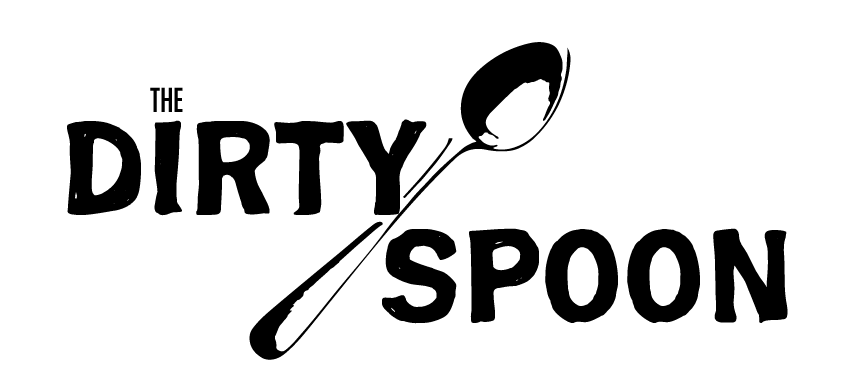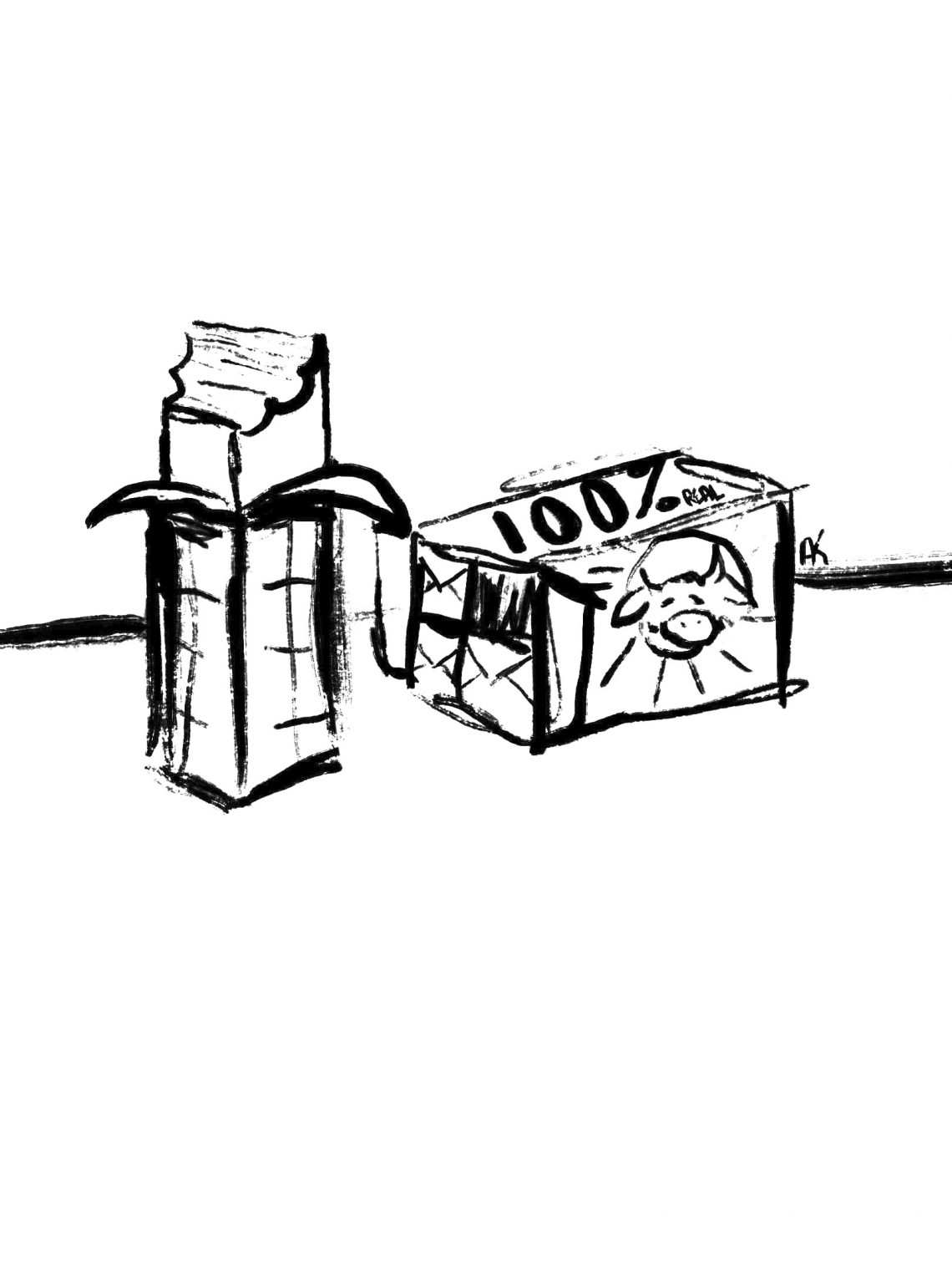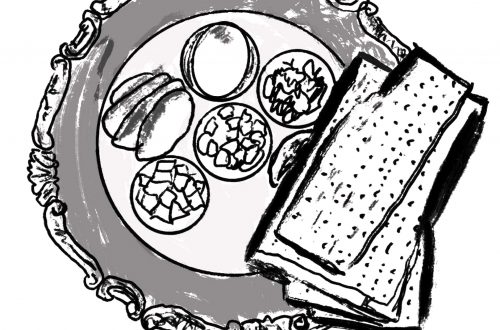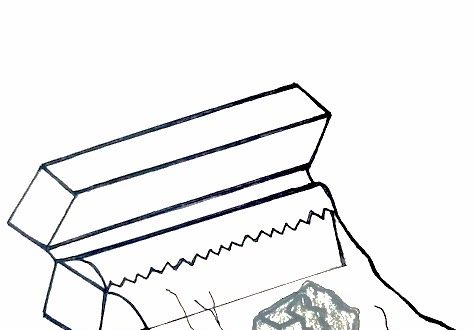by Jean Feldeisen
Jean’s essay is featured in episode 48 of The Dirty Spoon Radio Hour.
Butter is Better
My dad was a great one for getting in on a trend. He had the first television in our neighborhood and talked about owning a microwave oven long before they were available for home kitchens. I remember the day he came home from the grocery store with a box of margarine to replace our butter. It was white and came with a little packet of yellow food coloring.
I hated it instantly. Margarine was gross. It was chalky white instead of yellow, and it was slimy. It reminded me of dad’s hair cream. I decided then and there that this awful stuff would never pass my lips. Although my parents usually insisted that we eat everything on our plates, surprisingly, they never made a big deal about this rebellion. I knew not to make a big deal about it either. Whenever I had a choice I would eat butter. If my only choice was margarine I skipped the spread.
I thought margarine had been invented in the 50s when my dad first brought it home. I later learned that the first butter substitute was invented by a French chemist, Hippolyte Mege-Mouires, in response to a call by Napoleon III for a cheap alternative to butter for his armies during the Franco-Prussian War. His recipe was made of beef tallow churned with milk and was patented in 1869. In 1871, Henry W. Bradley of New York first used vegetable oils (mostly cottonseed oil) to create Margarine for the first time. Later, after the invention of the process of hydrogenation, the shortage of animal fats in the Depression led to the increased production of white sticks of Margarine as a cheap alternative to butter. For a time, companies colored the spread to resemble butter. Then that became illegal, lest the consumer be tricked into thinking they were buying butter. So, little packets of food coloring were included. The housewife, who this was primarily marketed to, could stir them into the margarine to make it look like butter. The laws changed again and manufacturers were allowed to sell it with the yellow color already mixed in. I didn’t know or care about any of that. I had made up my mind at age seven that I wasn’t going to eat it. Period.
And I stuck to that decision. Because of this self-imposed rule, I’ve lived my whole life suspicious of the actual contents of so-called “butter dishes.” I soon learned that certain people always used margarine─ like my paternal grandmother. At her house, I didn’t eat “butter” because I knew it wasn’t butter. Other people sometimes used butter and sometimes used margarine, so I’d have to politely inquire about this, or surreptitiously check out what was in their fridge before I sat down at the table.
If I didn’t have the nerve to ask or snoop around, I’d check out the contents of the dish itself once it was placed on the table. It was often hard to tell the difference between margarine and butter just by looking. Both were whitish-yellow and came in the same size solid sticks to fit into the same rectangular butter dishes. I could tell whether it was butter or margarine by tasting a bit, but that was pretty risky, akin to siphoning gasoline. I did not want to risk getting it in my mouth. Sometimes, if no one was watching, I could try to decide by smearing a little bit around in the dish with a knife. Margarine looked softer, kind of sleazy.
I never came out and said, “I don’t eat margarine.” After all, I was a little girl raised in the 50s. My father was strict about our behavior, especially when visiting, and we were taught to be polite, eat whatever was put on our plate without complaint, and show gratitude to our hosts. We were discouraged from asserting ourselves, giving our opinions, or making any sort of scene. So I needed to find a way to appear pleasant and agreeable while getting my own way.
I don’t need a spread on my toast,” I’d claim when the butter dish came my way. “I like it dry.”
Heaven forbid someone had the nerve to smear my bread or vegetable with a greasy glob of margarine before I could stop them. Yuck! Then I was forced to somehow get rid of the whole thing.
“I’m not hungry anymore,” I’d say. Or “I just got a stomachache.”
If this didn’t work, I might discreetly wrap the offensive food in my napkin or feed it to the dog under the table.
As far as most people at the time were concerned, margarine had several things going for it. It was cheaper than butter, and it was made from vegetable oils which did not contain saturated fats. It was thought to be healthier than butter. (Do you believe scientists thought they were doing the public a service by figuring out how to hydrogenate vegetable oils and create trans-fats?)
Once I grew up and was able to buy my own groceries, I’ve never been without several pounds of butter in my freezer. I continue to avoid margarine, even though it now comes in cute colored plastic tubs with more fantastical health claims because it is softer. I am not persuaded. And now that I’m older, I’m more comfortable asking about the food when eating out. If in doubt about whether its margarine or butter, I’ll just ask. I have no problem saying “I eat butter but I don’t eat margarine.”
Nowadays we all know that my first instincts about the dangers of this fake butter pretender were absolutely right. Most of us have seen the research that shows the danger of eating products like margarine made from hydrogenated vegetable oils. These products are high in saturated fats and trans-fats and have been linked to coronary artery disease.
Butter, however, is a minimally processed dairy product made from the cream of (preferably grass-fed) cows. It contains all the nutrients stored in grass. It is higher in omega-three fatty acids than omega-six and, therefore, good for your aging brain. It is one of the best natural sources of fat-soluble vitamins A, D, K, and E. It turns out that fats are good for us. Hydrogenated vegetable oils? Not so much.
Besides being delightfully creamy and sensuously buttery-yellow, real butter is good for me and for you, too. But, even if the research changes tomorrow, and scientists announce margarine is healthier than tofu, you’ll find me slathering butter on my toast every morning. At 73, I’m old enough to speak my truth and to know what I like.
And what I like is butter.
Original artwork by Alex Knighten
About the Author
Jean Anne Feldeisen is a practicing psychotherapist, a grandmother, and a writer. She has written for “Next Avenue,” ” Chicken Soup for the Soul” and is a host for the Crows Feet: Life As We Age Podcast. Her poetry has been published in “Thimble Literary Magazine,” “The Raven’s Perch,” “The Hopper,” and “Spank the Carp.” and other publications and anthologies. Her first poetry chapbook, Not All Are Weeping, was released in May of 2023 by Main Street Rag Publishing Company. Follow her at jeanfeldeisen.com





